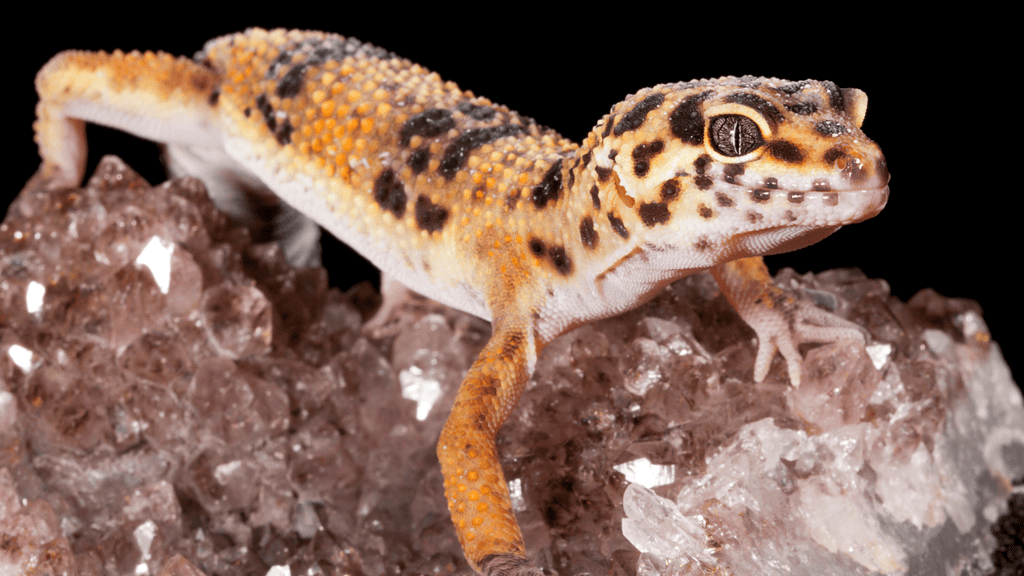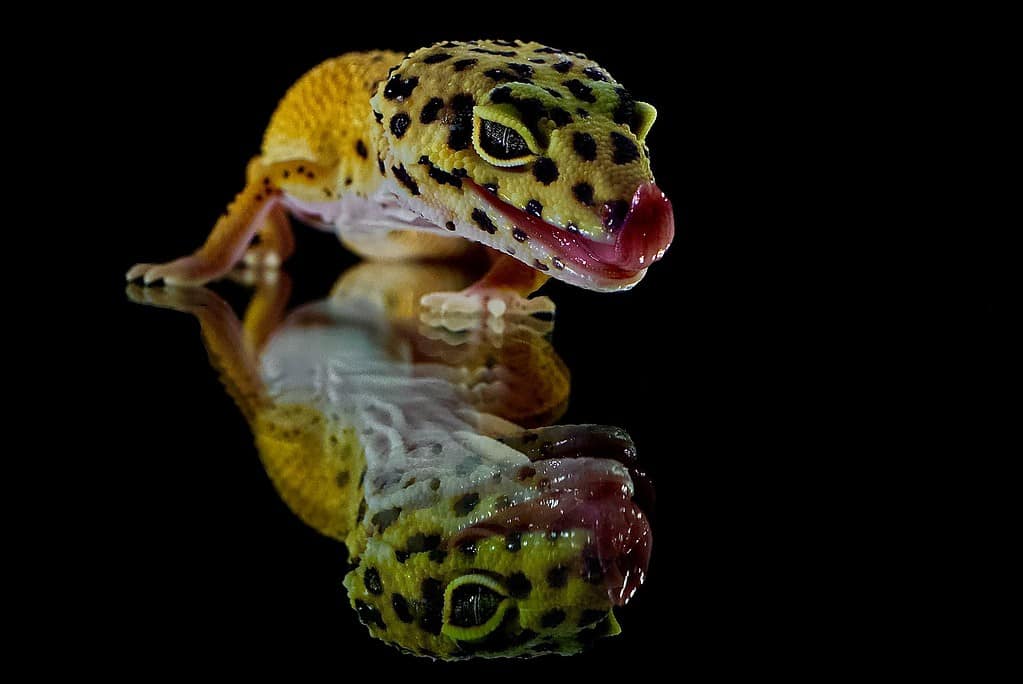Geckos are often considered the cutest reptile species that may be kept as pets. They are easy to handle, but it’s fascinating to see these small animals defy gravity. Leopard geckos may not enjoy climbing like other gecko species, yet they’re great climbers. So, in that context, let’s discuss what can Leopard Geckos climb?

Leopard geckos climb on rocks, branches, decorations, and other things related to their environments. They prefer to climb on horizontal surfaces because they do not possess the setae found on other geckos, which allows them to climb vertical surfaces.
Read on to learn about this charming species and how to house them properly, so they love climbing.
Can Leopard Geckos Climb?
Yes! Leopard geckos can climb. If you have a pet, you will observe them climbing trees and soaking wet hides. Leopard geckos like to remain low to the ground is a significant characteristic of these reptiles.
However, this doesn’t mean that they do not enjoy climbing or that they are unable to climb. They are excellent climbers, mostly on nonslippery surfaces. However, several factors should not be overlooked. Leopard geckos can’t climb everywhere like other lizards and geckos.
Why Do Leopard Geckos Enjoy Climbing?
They have a remarkable capacity to climb both horizontally and vertically. However, they are not only doing this for amusement purposes. A leopard gecko would ideally spend most of its time on the ground. This is because they obtain most of their body heat from sunbathing on rocks that the early light has warmed.
The primary reasons leopard geckos climb trees are to search for food and to avoid being eaten by predators. The fact that insects seek refuge and protection in trees from the intense afternoon sun makes it more difficult for a leopard gecko to eat. Because of this, a leopard gecko will often need to ascend to locate prey suitable for eating.
A leopard gecko left out in the open desert is highly susceptible to attack. The leopard gecko has increased stress levels on the desert’s ground floor because it is aware that this is not the safest place to be. Trees provide the perfect protection for a leopard gecko against any attack mode.
Therefore, a leopard gecko would benefit greatly from adopting this defensive strategy. So, climbing is more of a way to stay alive than a fun thing to do.
What Do Leopard Geckos Climb?
Deserts which are arid and rocky, are their natural habitat. Animals often face many dangers in this area, and there aren’t many trees to climb. Leopard Geckos can scale rocks and escape their enemies because of the claws on their feet. They are rock climbers who make a living at it. For their enjoyment, it would be best to make their enclosure look like this. In addition to that, they prefer to climb on tree branches, decorations, and even people.
A strong attachment between you and your pet can be established by facilitating the geckos climbing on you. You may start by holding them and letting them climb on your skin. Afterwards, you may make them climb on your arms and shoulders while seated on the ground. Make sure you close check on them to prevent your gecko from getting knocked over.
The use of a gecko hammock is something else that might be fun for your pet gecko. These items, often constructed of synthetic fibres or rope, provide a place for your gecko to relax and warm while basking in the sun. Before allowing your gecko to use it as a bed, check to see that it is stable. They could also find climbing on artificial plants or chalets made of man-made materials fun.
Accessories for Leopard Gecko Climbing
You may provide your leopard gecko with a place to climb and explore by using a variety of various climbing accessories. These are some of the most common options:
- Rocks: You can find rocks for sale at the majority of pet stores as well as online. To build an interesting enclosure, you need to be sure to purchase a variety of shapes and sizes.
- Branches: Purchase a branch from a nearby nature center or pet store to use as a branch. Before you put it in your tank, check to see if it is sufficiently strong.
- Hammocks: There is a wide variety of hammocks available on the market that geckos can use. In most cases, artificial fibers or ropes are used to construct them.
- Artificial Hideaway: These can be obtained at most pet stores and constructed out of plastic, resin, or wood. Additionally, they come in various sizes.
- Fake Plants: Most pet stores and online stores sell artificial plants. If you want your cage to seem attractive, be sure you buy a range of different-sized and shaped pieces.
Can Leopard Geckos Climb up Walls?
No! Leopard geckos are unable to climb vertical surfaces. This is because their feet do not have sticky toe pads. Leopard geckos have difficulty climbing vertical surfaces due to this trait.
Other lizards can climb walls by making force with the hairs on their feet. As a result of the absence of these fine hairs on their feet, leopard geckos have a more difficult time scaling vertical surfaces. Also, leopard geckos don’t have pads that stick to walls and surfaces like other lizards.
Can Leopard Geckos Climb up Stairs?
Leopard geckos can’t climb stairs with a slippery surfaces. Leopard geckos can adhere their feet to stairs and climb if the surface is not slippery. The feet and toes of leopard geckos are equipped with claws that allow them to improve their grip on non-slippery surfaces.
Can Leopard Gecko Climb Plastic?
Leopard geckos’ claws on their toes make it impossible for them to climb on plastic. If you keep geckos as pets, you’ve probably seen that they frequently try to grab hold of the plastic walls of their enclosure, but they are unable to do so. They can climb plastic, walls, stairs, and various other surfaces because of their unique foot and clawed toes, which are not found in other reptiles.

Can Leopard Geckos Climb Wooden Surfaces?
Leopard geckos can climb trees and wood in their enclosure. This is because these trees are either fake or quite small. Their wood is not slick, and a leopard gecko doesn’t have to climb very high to get to the branches.
Leopard geckos can climb trees as long as the bark is smooth enough to plant their feet firmly for support. The bark of trees not growing in a vertically straight line is rough and slippery.
Why Can’t Leopard Geckos Climb up Walls and Glass?
Leopard geckos don’t adapt to climb walls, glass, or polished rocks. Leopard geckos have scaled and hairy toe pads to assist them in climbing down rocks and trees in the wild.
These claws allow them to cling to cliffs or utilize them as hooks while climbing trees or rocks. This lack of adhesiveness prevents them from climbing upwardly smooth surfaces in the wild.
There is a possibility that you are under the impression that leopard geckos are capable of climbing because they have claws on their feet. The claws, which function similarly to human fingernails or nails, are adapted to facilitate the animal’s ability to seize its prey. The claw has a scratch pad to help it hold slippery prey like crickets and moths without squeezing too hard.
Some geckos have glands on their skin that make a glue-like substance that helps them stick to smooth vertical surfaces. As a result of the absence of this adhesive on their claws, leopard geckos cannot mount smooth vertical surfaces such as glass or walls.
Do Leopard Geckos Climb When Being Handled?
When your leopard gecko is used to being handled, it will love to climb all over you. Much like the vast majority of other species of reptiles, Leopard geckos will frequently look for a raised area that is flattened down. This is why reptiles do not often want to sit on your shoulder. Your shoulder gives it the height it needs and the flat, even surface it likes.
